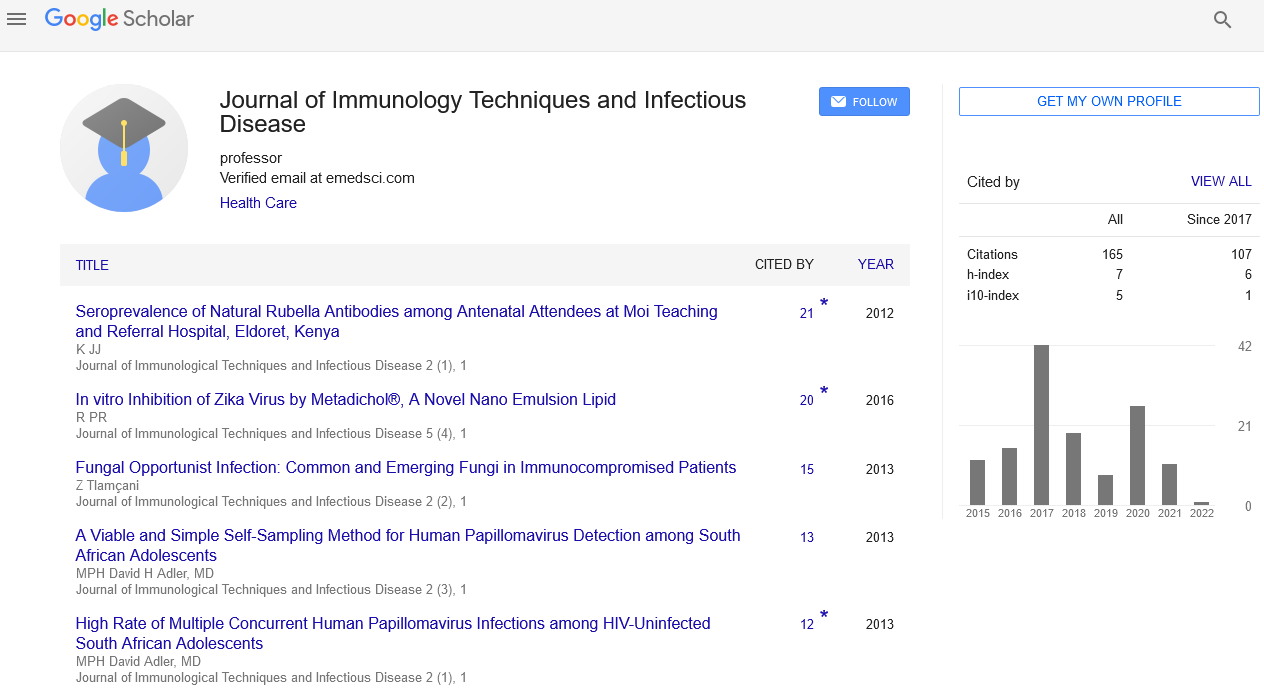Opinion Article, J Immunol Tech Infect Dis Vol: 12 Issue: 2
Latex Agglutination: Useful Diagnostic Tool in Medicine and Biology
Pruvi Kaur*
1Department of Bioscience, Fukui Prefectural University, Fukui, Japan
*Corresponding Author: Pruvi Kaur,
Department of Bioscience, Fukui Prefectural
University, Fukui, Japan
E-mail: pruvikaur112@gmail.com
Received date: 29 May, 2023, Manuscript No. JIDIT-23-105434;
Editor assigned date: 31 May, 2023, PreQC No. JIDIT-23-105434 (PQ);
Reviewed date: 14 June, 2023, QC No. JIDIT-23-105434;
Revised date: 21 June, 2023, Manuscript No. JIDIT-23-105434 (R);
Published date: 28 June, 2023, DOI: 10.4172/2329-9541.1000344.
Citation: Kaur P (2023) Latex Agglutination: Useful Diagnostic Tool in Medicine and Biology. J Immunol Tech Infect Dis 12:2.
Description
In the field of diagnostics, medical and biological laboratories rely on accurate and efficient methods to detect various diseases and conditions. Among the arsenal of diagnostic techniques, latex agglutination has emerged as a versatile tool for identifying antigens and antibodies. This explores the principles, applications, and advantages of latex agglutination, highlighting its significance in clinical and research settings.
Principles of latex agglutination
Latex agglutination is based on the principle of antigen-antibody interactions. It utilizes tiny latex beads coated with either specific antibodies or antigens when mixed with a sample containing the target antigen or antibody, the latex beads aggregate or agglutinate, forming visible clumps or a lattice network. The extent of agglutination is proportional to the concentration of the analyte present in the sample.
Applications in clinical diagnostics
Latex agglutination finds wide application in clinical diagnostics, allowing for rapid and reliable identification of various pathogens and diseases. One of the most common uses is in the detection of bacterial and viral infections. For instance, Streptococcus pneumoniae, Haemophilus influenzae, and Neisseria meningitidis can be identified through latex agglutination tests targeting specific bacterial antigens. Similarly, latex agglutination assays are valuable for detecting viral antigens, such as those associated with influenza and respiratory syncytial virus infections.
In addition to infectious diseases, latex agglutination is employed in the diagnosis of autoimmune disorders. For instance, rheumatoid factor, an antibody frequently found in patients with rheumatoid arthritis, can be detected using this technique. Moreover, latex agglutination plays a important role in blood typing and crossmatching for blood transfusions, as it allows for the identification of ABO and Rh blood group antigens.
Advantages
The popularity of latex agglutination stems from its numerous advantages. Firstly, it is a rapid test that can yield results within minutes, making it valuable in emergency situations and for prompt decision-making. Secondly, the technique is relatively simple and can be performed using basic laboratory equipment, reducing the need for specialized instrumentation. This simplicity makes it accessible to laboratories with limited resources. Furthermore, latex agglutination tests are highly specific and sensitive, providing accurate results even at low analyte concentrations. These qualities contribute to its widespread use in clinical settings.
Versatility in research applications
Beyond clinical diagnostics, latex agglutination also finds applications in various research fields. In immunology research, it plays a pivotal role in studying the interactions between antigens and antibodies. By utilizing latex beads coated with specific antigens, researchers can identify the presence of antibodies in biological samples. This facilitates the investigation of immune responses, antigen-antibody binding kinetics, and the development of diagnostic assays.
Furthermore, latex agglutination is valuable in the field of microbiology. It enables the rapid identification and differentiation of bacterial and fungal species by detecting specific microbial antigens. This aids in the identification of pathogens and assists in epidemiological studies.
Limitations
While latex agglutination is a powerful diagnostic tool, it does have certain limitations. One major challenge is the possibility of falsepositive or false-negative results. Factors such as improper sample handling, contamination, or the presence of interfering substances can affect the accuracy of the test. Additionally, the availability of commercial latex reagents for less common or emerging pathogens may be limited, reducing its applicability in certain cases. It is important to carefully validate and interpret the results obtained through latex agglutination, considering the clinical context and potential confounding factors.
Conclusion
As technology continues to advance, new developments in latex agglutination are anticipated. Researchers are exploring the integration of nanotechnology and molecular biology techniques to enhance the sensitivity and specificity of the assay. Additionally, efforts are being made to expand the range of available latex reagents to cover a broader spectrum of pathogens and antigens. These advancements hold the potential to further improve the diagnostic capabilities of latex agglutination, making it an even more indispensable tool in medical and biological research.
Latex agglutination has established itself as a versatile and reliable diagnostic tool in both clinical and research settings. Its ability to rapidly detect a wide range of antigens and antibodies has made it invaluable in the diagnosis of infectious diseases, autoimmune disorders, and blood typing. With its simplicity, speed, and accuracy, latex agglutination continues to play a vital role in modern healthcare and scientific research. As advancements in technology and reagent availability continue, the future of latex agglutination holds great promise in revolutionizing diagnostics and improving patient care.
 Spanish
Spanish  Chinese
Chinese  Russian
Russian  German
German  French
French  Japanese
Japanese  Portuguese
Portuguese  Hindi
Hindi 
